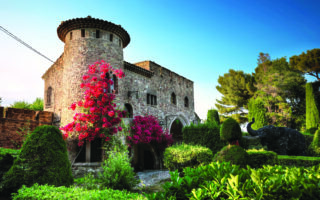Icons: The Onion Johnnies
The Breton traders and their pink Roscoff alliums were once a familiar sight on Britain’s streets, says Heidi Fuller-love
As late as the 1960s, Onion Johnnies, the Breton farmers and labourers who cycled from door-to-door selling strings of pink Roscoff onions, were a familiar sight on Britain’s streets. With their jaunty berets and Gauloise cigarettes, they became – in the era before mass travel – many British people’s idea of a typical Frenchman.
Their wares are still prized by top chefs, including Raymond Blanc of Le Manoir aux Quat’ Saisons, when it comes to making the best onion soup. As for Britain’s housewives, they swore by the crisp, sugary, pink-fleshed onion produced just across the Channel.
For centuries, countless households in Brittany had survived from farming and selling the onions in France. Oversupply drove down prices, so in the 1820s, Breton farmer Henri Ollivier had the idea of looking across the Channel for a new market. By the end of the century, hundreds of onion vendors were leaving home each year to make the often perilous journey in small open boats to Plymouth or Portsmouth to sell their oignon rose.
It was a hard life stringing onions together into long plaits and then hiking from door-to-door, but most Johnnies still found it preferable to selling in France, where vast distances, a lack of public transport and lower prices made their task even more arduous.
By the late 1920s, business was booming, and thousands of Onion Johnnies were crossing the Channel each season, carrying their pink bulbs on a long pole or slung over the handlebars of a bike. One British pensioner whose mother was a customer remembers: “They usually wore striped shirts and smoked a Gauloise cigarette. Not many spoke a lot of English, although they did know the language of their trade.”
Too many cooks spoil the broth, however, and the Great Depression of the early 1930s hit business. François Keriven, who followed his father into the trade, said in an interview with the Brittany Ferries magazine: “My father would go to a house and knock on the door, and ask if they wanted to buy onions. They would often say, ‘No, someone’s already been – and we had four call yesterday.’”
By the middle of the decade, the numbers on Britain’s streets had dwindled to around 400, and then the outbreak of war stopped the trade altogether. However, after peace was declared in 1945, there was such a scarcity of fresh vegetables in Britain that the Onion Johnnies were welcomed back with open arms. Life was still hard for the itinerant onion sellers, who would leave their homes and their families for months to live in a country where the lifestyle was totally different. They were usually housed in the warehouses where the onions were stocked, so their skins became impregnated with the smell, which made socialising outside their own circle very difficult.
There was also the weather to contend with: the onions often rotted in the humid climate, and when the Channel was rough, entire cargoes could end up at the bottom of the sea, often taking the lives of onion sellers, too.
By the 1970s, large ferries replaced the smaller vessels that once made the crossing. Since goods could now be exported to Britain easily and cheaply, it was no longer worthwhile for the onion sellers to trek across the Channel, and by the end of the 20th century, only a handful were seen on Britain’s streets.
Any fears that the Onion Johnnies would be forgotten were soon dispelled. The Maison des Johnnies et de l’Oignon de Roscoff, a museum dedicated to the life and times of Brittany’s onion hawkers, opened in the port in 2004. Five years later, the pink-tinged Roscoff onion gained Appellation d’Origine Controlée status, followed in 2013 by the Appellation d’Origine Protégée.
Today, with the revival of interest in locally grown produce, Roscoff’s sugary onions have taken their place on the illustrious list of France’s best-loved culinary traditions – and the men in striped shirts who once sold them are hailed as icons.
DID YOU KNOW?
• A stone gargoyle on a house in Place Lacaze Duthiers in Roscoff depicts an Onion Johnny with a string of onions.
• More than 70 Onion Johnnies were among those who died when the passenger ship Hilda ran aground near Saint-Malo after a voyage from Southampton in 1905.
• Onion Johnnies did well in Wales because the similarities between the Breton and Welsh languages made it easier for them to communicate.
If you liked this article, try these too:
Saddle up! Dreamy horse riding experiences in France
These French deisigners can help your with next decorating project
Share to: Facebook Twitter LinkedIn Email
More in french icon


